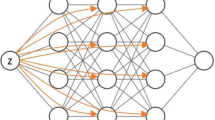Abstract
To price floating strike lookback options, we obtain a partial differential equation (PDE) according to the double Heston model. To solve the PDE, we employ a deep learning algorithm called the deep Galerkin method (DGM), which is well-suited for high-dimensional PDEs. Finally, we compare the obtained results from mentioned method with the option price under the Monte Carlo simulation method.














Similar content being viewed by others
References
Albrecher H, Mayer P, Schoutens W, Tistaert J (2007) The little Heston trap. Wilmott 1:83–92
Buchen P, Konstandatos O (2005) A new method of pricing lookback options. Math Finance Int J Math Stat Financ Econ 15(2):245–259
Christoffersen P, Heston S, Jacobs K (2009) The shape and term structure of the index option smirk: why multifactor stochastic volatility models work so well. Manag Sci 55(12):1914–1932
Conze A, Viswanathan R (1991) Path dependent options: the case of lookback options. J Finance 46(5):1893–1907
Deng G (2020) Pricing perpetual American floating strike lookback option under multiscale stochastic volatility model. Chaos Solitons Fract 141:110411
Dokuchaev GZ, Wang MS (2022) A modification of Galerkin’s method for option pricing. J Ind Manag Optim 18(4):2483
Duffy DJ (2013) Finite difference methods in financial engineering: a partial differential equation approach. Wiley, New York
Fallah S, Mehrdoust F (2019) On the existence and uniqueness of the solution to the double Heston model equation and valuing lookback option. J Comput Appl Math 350:412–422
Forsyth P, Vetzal K, Zvan R (1999) A finite element approach to the pricing of discrete lookbacks with stochastic volatility. Appl Math Finance 6(2):87–106
Gauthier P, Possamaï D (2010) Efficient simulation of the double Heston model, Available at SSRN 1434853
Goldman MB, Sosin HB, Gatto MA (1979) Path dependent options: “buy at the low, sell at the high’’. J Financ 34(5):1111–1127
Han J, Jentzen A, Weinan E (2018) Solving high-dimensional partial differential equations using deep learning. Proc Natl Acad Sci 115(34):8505–8510
Heston SL (1993) A closed-form solution for options with stochastic volatility with applications to bond and currency options. Rev Financ Stud 6(2):327–343
Hilber N, Reichmann O, Schwab C, Winter C (2013) Computational methods for quantitative finance: finite element methods for derivative pricing. Springer Science & Business Media, Berlin
Hochreiter S, Schmidhuber J (1997) Long short-term memory. Neural Comput 9(8):1735–1780
Lagaris IE, Likas A, Fotiadis DI (1998) Artificial neural networks for solving ordinary and partial differential equations. IEEE Trans Neural Netw 9(5):987–1000
Lee M-K (2017) Pricing perpetual American lookback options under stochastic volatility. Comput Econ 53(3):1265–1277
Lee H, Kang IS (1990) Neural algorithm for solving differential equations. J Comput Phys 91(1):110–131
Leung KS (2013) An analytic pricing formula for lookback options under stochastic volatility. Appl Math Lett 26(1):145–149
Malek A, Beidokhti RS (2006) Numerical solution for high order differential equations using a hybrid neural network-optimization method. Appl Math Comput 183(1):260–271
Raissi M, Perdikaris P, Karniadakis GE (2019) Physics-informed neural networks: a deep learning framework for solving forward and inverse problems involving nonlinear partial differential equations. J Comput Phys 378:686–707
Shreve SE (2004) Stochastic calculus for finance II: continuous-time models, vol 11. Springer Science & Business Media, Berlin
Sirignano J, Spiliopoulos K (2018) Dgm: a deep learning algorithm for solving partial differential equations. J Comput Phys 375:1339–1364
Srivastava RK, Greff K, Schmidhuber J (2015) Training very deep networks, arXiv preprint arXiv:1507.06228
Weinan E, Han J, Jentzen A (2017) Deep learning-based numerical methods for high-dimensional parabolic partial differential equations and backward stochastic differential equations. Commun Math Stat 5(4):349–380
Wilmott P (2013) Paul Wilmott on quantitative finance. Wiley, New York
Wong HY, Chan CM (2007) Lookback options and dynamic fund protection under multiscale stochastic volatility. Insur Math Econ 40(3):357–385
Yu B (2018) The deep Ritz method: a deep learning-based numerical algorithm for solving variational problems. Commun Math Stat 6:1–12
Zang Y, Bao G, Ye X, Zhou H (2020) Weak adversarial networks for high-dimensional partial differential equations. J Comput Phys 411:109409
Zhu Y, Zabaras N, Koutsourelakis P-S, Perdikaris P (2019) Physics-constrained deep learning for high-dimensional surrogate modeling and uncertainty quantification without labeled data. J Comput Phys 394:56–81
Author information
Authors and Affiliations
Contributions
All authors contributed to the study conception and design.
Corresponding author
Ethics declarations
Conflict of interest
We declare that we have no conflict of interest.
Additional information
Communicated by Silvana Manuela Pesenti.
Publisher's Note
Springer Nature remains neutral with regard to jurisdictional claims in published maps and institutional affiliations.
Rights and permissions
Springer Nature or its licensor (e.g. a society or other partner) holds exclusive rights to this article under a publishing agreement with the author(s) or other rightsholder(s); author self-archiving of the accepted manuscript version of this article is solely governed by the terms of such publishing agreement and applicable law.
About this article
Cite this article
Motameni, M., Mehrdoust, F. & Najafi, A.R. Lookback option pricing under the double Heston model using a deep learning algorithm. Comp. Appl. Math. 41, 378 (2022). https://doi.org/10.1007/s40314-022-02098-5
Received:
Revised:
Accepted:
Published:
DOI: https://doi.org/10.1007/s40314-022-02098-5




